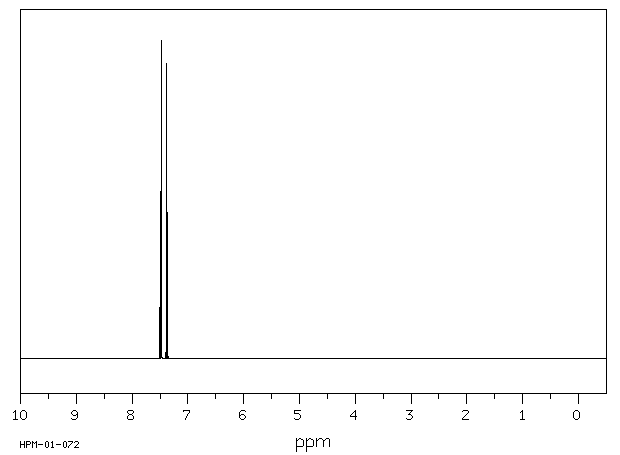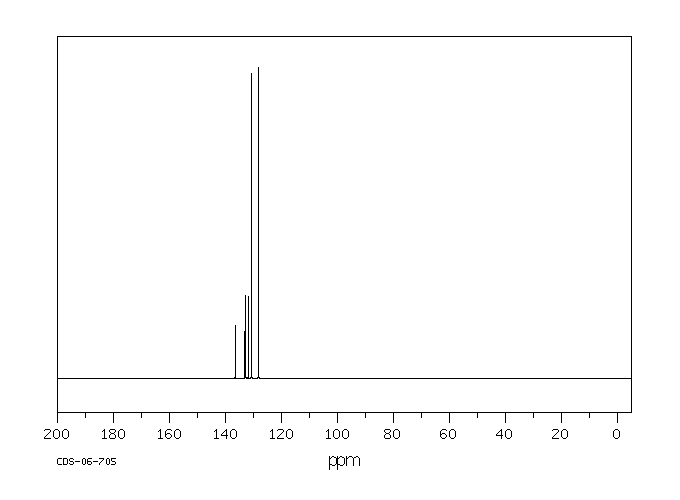2,2',3,3',6,6'-六氯联苯 | 38411-22-2
-
物化性质
-
计算性质
-
ADMET
-
安全信息
-
SDS
-
制备方法与用途
-
上下游信息
-
文献信息
-
表征谱图
-
同类化合物
-
相关功能分类
-
相关结构分类
物化性质
-
熔点:114.2°C
-
沸点:446.99°C (rough estimate)
-
密度:1.5940 (rough estimate)
-
溶解度:1.25e-08 M
-
亨利常数:8.80e-05 atm-m3/mole
-
保留指数:2088;2090;2118
计算性质
-
辛醇/水分配系数(LogP):7.1
-
重原子数:18
-
可旋转键数:1
-
环数:2.0
-
sp3杂化的碳原子比例:0.0
-
拓扑面积:0
-
氢给体数:0
-
氢受体数:0
ADMET
安全信息
-
海关编码:2903999090
SDS
上下游信息
-
上游原料
中文名称 英文名称 CAS号 化学式 分子量 2,2',6,6'-四氯联苯 2,2',6,6'-tetrachlorobiphenyl 15968-05-5 C12H6Cl4 291.992 -
下游产品
中文名称 英文名称 CAS号 化学式 分子量 2,2’,3,5’,6-戊氯联苯 2,3,6,2',5'-pentachlorobiphenyl 38379-99-6 C12H5Cl5 326.437 2,2’,3,6,6’-戊氯联苯 2,2',3,6,6'-Pentachlorobiphenyl 73575-54-9 C12H5Cl5 326.437 2,2',5,5'-四氯联苯 2,2',5,5'-Tetrachlorobiphenyl 35693-99-3 C12H6Cl4 291.992 2,6-二氯联苯 2,6-dichlorobiphenyl 33146-45-1 C12H8Cl2 223.102 2,2'-二氯联苯 2,2'-Dichlorobiphenyl 13029-08-8 C12H8Cl2 223.102
反应信息
-
作为反应物:参考文献:名称:BUSER, HANS-RUDOLF;RAPPE, CHRISTOFFER, ANAL. CHEM., 63,(1991) N3, C. 1210-1217摘要:DOI:
-
作为产物:参考文献:名称:2,2‘,3,3‘,6,6‘-Hexachlorobiphenyl Hydroxylation by Active Site Mutants of Cytochrome P450 2B1 and 2B11摘要:The structural basis of species differences in cytochrome P450 2B-mediated hydroxylation of 2,2',3,3',6,6'-hexachlorobiphenyl (236HCB) was evaluated by using 14 site-directed mutants of cytochrome P450 2B1 and three point mutants of 2B11 expressed in Escherichia coli, To facilitate metabolite identification, seven possible products, including three hydroxylated and four dihydroxylated hexachlorobiphenyls, were synthesized by direct functionalization of precursors and Ullmann and crossed Ullmann reactions, HPLC and GC/MS analysis and comparison with authentic standards revealed that 2B1 2B11, and all their mutants produced 4,5-dihydroxy-236HCB and 5-hydroxy-236HCB, while 2B11 L363V and 2B1 I114V mutants also catalyzed hydroxylation at the 4-position. The amount of products formed by 2B1 mutants I114V, F206L, L209A, T302S, V363A, V363L, V367A, I477A, I477L, G478S, I480A, and I480L was smaller than that of the wild type. I477V exhibited unaltered 236HCB metabolism, and I480V produced twice as much dihydroxy product as the wild type, For 2B11, substitution of Val-114 or Asp-290 with lie decreased the product yields. Replacement of Leu-363 with Val dramatically altered the profile of 236HCB metabolites. In addition to an increase in the overall level of hydroxylation, the mutant mainly catalyzed hydroxylation at the 4-position. Incubation of P450 2B1 with 5-hydroxy-236HCB produced 4,5-dihydroxy-236HCB, which indicates that 4,5-dihydroxy-236HCB may be formed by a direct hydroxylation of 5-hydroxy-236HCB. The findings from this study demonstrate the importance of residues 114, 206, 209, 302, 363, 367, 477, 478, and 480 in 2B1 and 114, 290, and 363 in 2B11 for 236HCB metabolism.DOI:10.1021/tx990030j
文献信息
-
Studies of the antenna effect in polymer molecules. 23. Photosensitized dechlorination of 2,2',3,3',6,6'-hexachlorobiphenyl solubilized in an aqueous solution of poly(sodium styrenesulfonate-co-2-vinylnaphthalene)作者:M. Nowakowska、E. Sustar、James E. GuilletDOI:10.1021/ja00001a036日期:1991.12prime},3,3prime},6,6prime}-hexachlorobiphenyl (HCB) solubilized in an aqueous solution of poly(sodium styrenesulfonate-co-2-vinylnaphthalene) (PSSS-VN) was studied with use of solar-simulated radiation. The reaction was found to be photosensitized by the naphthalene antenna units present in the copolymer. Studies performed in a low molecular weight model system have shown that dechlorination of HCB may
-
Instruments for detecting low-molecular weight substance申请人:Mizukami Haruki公开号:US20050148097A1公开(公告)日:2005-07-07To provide the following instruments 1 and 2 as a low-molecular-weight substance detection instrument employing immunochromatography capable of detecting conveniently and sensitively detecting a low-molecular weight substance such as an environmental pollutant (e.g., a dioxin), as a target substance contained in a test sample: 1. an instrument, which comprises 1) a test sample application section with which a test sample is brought into contact; 2) a label product reaction section containing a label product containing, as a portion thereof, an antibody capable of binding to a target substance contained in the test sample, the label product being not bound to the reaction section; 3) an unbound label product capturing section containing an element capable of capturing the label product which is not bound to the target substance, the element being bound to the capturing section; and 4) a detection section containing a detection element which, when coming into contact with the target substance bound to the label product, causes a visually observable change, and 2. an instrument wherein a test sample is reacted with a labeled antibody containing, as a portion thereof, an antibody capable of binding to a target substance contained in the test sample, and the resultant reaction product is employed for detecting the target substance contained in the test sample.提供以下仪器1和2作为低分子量物质检测仪器,采用免疫层析技术,能够方便敏感地检测低分子量物质,例如环境污染物(例如二恶英),作为测试样品中包含的目标物质:1. 仪器,包括1)测试样品应用部分,用于将测试样品接触;2)标签产物反应部分,包含一种标签产物,其中包含一种能够结合到测试样品中的目标物质的抗体,标签产物未结合到反应部分;3)未结合标签产物捕获部分,包含一种能够捕获未结合到目标物质的标签产物的元素,该元素与捕获部分结合;以及4)检测部分,包含一种检测元素,当与结合到标签产物的目标物质接触时,会引起可视的变化;2. 仪器,其中测试样品与标记抗体反应,其中一部分包含能够结合到测试样品中的目标物质的抗体,产生的反应产物用于检测测试样品中包含的目标物质。
-
Dose‐dependent enantiomeric enrichment of 2,2′,3,3′,6,6′‐hexachlorobiphenyl in female mice作者:Izabela Kania‐Korwel、Keri C Hornbuckle、Larry W. Robertson、Hans‐Joachim LehmlerDOI:10.1897/07-359r.1日期:2008.2
Abstract Nineteen of the 209 possible polychlorinated biphenyl (PCB) congeners are chiral and stable to racemization at ambient temperature. Chiral PCB congeners are important components of technical and environmental PCB mixtures, and some are highly toxic. Both environmental and laboratory studies have shown that these chiral PCB congeners undergo enantiomeric enrichment in many species; however, the processes and factors influencing the extent of this enantiomeric enrichment are poorly understood. We hypothesized that the exposure levels are an important factor affecting the extent of enantiomeric enrichment. To test this hypothesis, we investigated the levels and enantiomeric fractions of (±)‐PCB 136 in selected tissues, feces, and urine of female C57Bl/6 mice 3 d after oral administration of 2.5, 10, or 50 mg/kg body weight of (±)‐PCB 136. The PCB 136 tissue levels typically increased with increasing dose. The extent of the enrichment of (+)‐PCB 136 in tissues and feces, however, decreased with increasing dose, an observation that suggests a saturation of the disposition process responsible for the enantiomeric enrichment. Overall, the present study demonstrates that in addition to species, exposure source, exposure frequency, and other factors, levels of PCB exposure are an important determinant of the enantiomeric enrichment of PCBs in mice and, most likely, other species.
摘要 209 种可能的多氯联苯(PCB)同系物中有 19 种是手性的,并且在环境温度下对消旋化稳定。手性多氯联苯同系物是技术和环境多氯联苯混合物的重要组成部分,其中一些具有剧毒。环境研究和实验室研究都表明,这些手性多氯联苯同系物在许多物种中都会发生对映体富集;然而,影响这种对映体富集程度的过程和因素却鲜为人知。我们假设,接触水平是影响对映体富集程度的一个重要因素。为了验证这一假设,我们研究了雌性 C57Bl/6 小鼠口服 2.5、10 或 50 毫克/千克体重的 (±)-PCB 136 3 天后,其特定组织、粪便和尿液中 (±)-PCB 136 的含量和对映体组分。多氯联苯 136 在组织中的含量通常会随着剂量的增加而增加。然而,组织和粪便中 (+)-PCB 136 的富集程度随着剂量的增加而降低,这一观察结果表明对映体富集的处置过程已经饱和。总之,本研究表明,除了物种、接触源、接触频率和其他因素外,多氯联苯的接触水平也是小鼠以及很可能其他物种体内多氯联苯对映体富集的重要决定因素。 -
INSTRUMENTS FOR DETECTING LOW-MOLECULAR WEIGHT SUBSTANCE申请人:Enbiotec Laboratories Co., Ltd.公开号:EP1489420A1公开(公告)日:2004-12-22To provide the following instruments 1 and 2 as a low-molecular-weight substance detection instrument employing immunochromatography capable of detecting conveniently and sensitively detecting a low-molecular weight substance such as an environmental pollutant (e.g., a dioxin), as a target substance contained in a test sample: 1. an instrument, which comprises 1) a test sample application section with which a test sample is brought into contact; 2) a label product reaction section containing a label product containing, as a portion thereof, an antibody capable of binding to a target substance contained in the test sample, the label product being not bound to the reaction section; 3) an unbound label product capturing section containing an element capable of capturing the label product which is not bound to the target substance, the element being bound to the capturing section; and 4) a detection section containing a detection element which, when coming into contact with the target substance bound to the label product, causes a visually observable change, and 2. an instrument wherein a test sample is reacted with a labeled antibody containing, as a portion thereof, an antibody capable of binding to a target substance contained in the test sample, and the resultant reaction product is employed for detecting the target substance contained in the test sample.提供以下仪器 1 和 2,作为一种采用免疫层析技术的低分子量物质检测仪器,能够方便、灵敏地检测作为检测样品中目标物质的低分子量物质,如环境污染物(如二恶英): 1.仪器,包括:1)测试样品应用部分,测试样品与之接触;2)标签产品反应部分,包含标签产品,作为其一部分,该标签产品含有能够与测试样品中所含目标物质结合的抗体,标签产品未与反应部分结合;3) 非结合标签产品捕获部分,包含能够捕获未与目标物质结合的标签产品的元件,该元件与捕获部分结合;以及 4) 检测部分,包含检测元件,该元件与结合在标签产品上的目标物质接触时,会引起视觉上可观察到的变化,以及 2. 2. 一种仪器,其中测试样品与标记抗体反应,标记抗体的一部分能够与测试样品中的目标物质结合,反应产物用于检测测试样品中的目标物质。
-
Probe compound for detecting and isolating enzymes and means and methods using the same申请人:Helmholtz-Zentrum für Infektionsforschung GmbH公开号:EP2230312A1公开(公告)日:2010-09-22The present invention relates to a probe compound that can comprise any substrate or metabolite of an enzymatic reaction in addition to an indicator component, such as, for example, a fluorescence dye, or the like. Moreover, the present invention relates to means for detecting enzymes in form of an array, which comprises any number of probe compounds of the invention which each comprise a different metabolite of interconnected metabolites representing the central pathways in all forms of life. Moreover, the present invention relates to a method for detecting enzymes involving the application of cell extracts or the like to the array of the invention which leads to reproducible enzymatic reactions with the substrates. These specific enzymatic reactions trigger the indicator (e.g. a fluorescence signal) and bind the enzymes to the respective cognate substrates. Moreover, the invention relates to means for isolating enzymes in form of nanoparticles coated with the probe compound of the invention. The immobilisation of the cognate substrates or metabolites on the surface of nanoparticles by means of the probe compounds allows capturing and isolating the respective enzyme, e.g. for subsequent sequencing.本发明涉及一种探针化合物,它可以包括酶反应的任何底物或代谢物,此外还包括指示成分,例如荧光染料或类似物。此外,本发明还涉及以阵列形式检测酶的方法,该阵列由任意数量的本发明探针化合物组成,每种探针化合物由代表所有生命形式中中心途径的相互关联的代谢物中的不同代谢物组成。此外,本发明还涉及一种检测酶的方法,该方法涉及将细胞提取物或类似物应用于本发明的阵列,从而导致与底物发生可重复的酶反应。这些特定的酶反应会触发指示剂(如荧光信号),并将酶与各自的同源底物结合。此外,本发明还涉及以涂覆有本发明探针化合物的纳米颗粒形式分离酶的方法。通过探针化合物将同源底物或代谢物固定在纳米颗粒表面,可以捕获和分离相应的酶,例如用于后续测序。
表征谱图
-
氢谱1HNMR
-
质谱MS
-
碳谱13CNMR
-
红外IR
-
拉曼Raman
-
峰位数据
-
峰位匹配
-
表征信息









